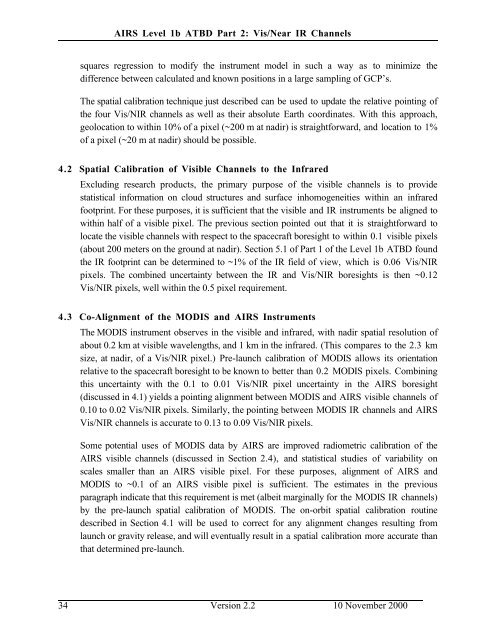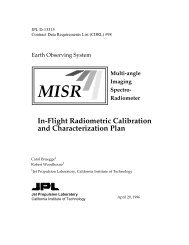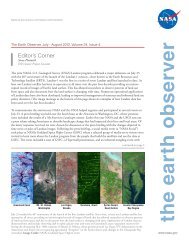AIRS Level 1B Visible/Near-Infrared Channels ATBD - NASA's Earth ...
AIRS Level 1B Visible/Near-Infrared Channels ATBD - NASA's Earth ...
AIRS Level 1B Visible/Near-Infrared Channels ATBD - NASA's Earth ...
You also want an ePaper? Increase the reach of your titles
YUMPU automatically turns print PDFs into web optimized ePapers that Google loves.
<strong>AIRS</strong> <strong>Level</strong> 1b <strong>ATBD</strong> Part 2: Vis/<strong>Near</strong> IR <strong>Channels</strong><br />
squares regression to modify the instrument model in such a way as to minimize the<br />
difference between calculated and known positions in a large sampling of GCP’s.<br />
The spatial calibration technique just described can be used to update the relative pointing of<br />
the four Vis/NIR channels as well as their absolute <strong>Earth</strong> coordinates. With this approach,<br />
geolocation to within 10% of a pixel (~200 m at nadir) is straightforward, and location to 1%<br />
of a pixel (~20 m at nadir) should be possible.<br />
4.2 Spatial Calibration of <strong>Visible</strong> <strong>Channels</strong> to the <strong>Infrared</strong><br />
Excluding research products, the primary purpose of the visible channels is to provide<br />
statistical information on cloud structures and surface inhomogeneities within an infrared<br />
footprint. For these purposes, it is sufficient that the visible and IR instruments be aligned to<br />
within half of a visible pixel. The previous section pointed out that it is straightforward to<br />
locate the visible channels with respect to the spacecraft boresight to within 0.1 visible pixels<br />
(about 200 meters on the ground at nadir). Section 5.1 of Part 1 of the <strong>Level</strong> 1b <strong>ATBD</strong> found<br />
the IR footprint can be determined to ~1% of the IR field of view, which is 0.06 Vis/NIR<br />
pixels. The combined uncertainty between the IR and Vis/NIR boresights is then ~0.12<br />
Vis/NIR pixels, well within the 0.5 pixel requirement.<br />
4.3 Co-Alignment of the MODIS and <strong>AIRS</strong> Instruments<br />
The MODIS instrument observes in the visible and infrared, with nadir spatial resolution of<br />
about 0.2 km at visible wavelengths, and 1 km in the infrared. (This compares to the 2.3 km<br />
size, at nadir, of a Vis/NIR pixel.) Pre-launch calibration of MODIS allows its orientation<br />
relative to the spacecraft boresight to be known to better than 0.2 MODIS pixels. Combining<br />
this uncertainty with the 0.1 to 0.01 Vis/NIR pixel uncertainty in the <strong>AIRS</strong> boresight<br />
(discussed in 4.1) yields a pointing alignment between MODIS and <strong>AIRS</strong> visible channels of<br />
0.10 to 0.02 Vis/NIR pixels. Similarly, the pointing between MODIS IR channels and <strong>AIRS</strong><br />
Vis/NIR channels is accurate to 0.13 to 0.09 Vis/NIR pixels.<br />
Some potential uses of MODIS data by <strong>AIRS</strong> are improved radiometric calibration of the<br />
<strong>AIRS</strong> visible channels (discussed in Section 2.4), and statistical studies of variability on<br />
scales smaller than an <strong>AIRS</strong> visible pixel. For these purposes, alignment of <strong>AIRS</strong> and<br />
MODIS to ~0.1 of an <strong>AIRS</strong> visible pixel is sufficient. The estimates in the previous<br />
paragraph indicate that this requirement is met (albeit marginally for the MODIS IR channels)<br />
by the pre-launch spatial calibration of MODIS. The on-orbit spatial calibration routine<br />
described in Section 4.1 will be used to correct for any alignment changes resulting from<br />
launch or gravity release, and will eventually result in a spatial calibration more accurate than<br />
that determined pre-launch.<br />
34 Version 2.2 10 November 2000







